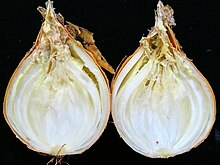| Dickeya dadantii | |
|---|---|

| |
| Soft rot in an onion caused by Dickeya dadantii or Pectobacterium carotovorum | |
| Scientific classification | |
| Domain: | Bacteria |
| Phylum: | Pseudomonadota |
| Class: | Gammaproteobacteria |
| Order: | Enterobacterales |
| Family: | Pectobacteriaceae |
| Genus: | Dickeya |
| Species: | D. dadantii
|
| Binomial name | |
| Dickeya dadantii Samson et al. 2005[1]
| |
Dickeya dadantii is a Gram-negative bacillus that belongs to the family Pectobacteriaceae. It was formerly known as Erwinia chrysanthemi but was reassigned as Dickeya dadantii in 2005.[2] Members of this family are facultative anaerobes, able to ferment sugars to lactic acid, have nitrate reductase, but lack oxidases. Even though many clinical pathogens are part of the order Enterobacterales, most members of this family are plant pathogens. D. dadantii is a motile, nonsporing, straight rod-shaped cell with rounded ends, much like the other members of the genus, Dickeya.[3] Cells range in size from 0.8 to 3.2 μm by 0.5 to 0.8 μm and are surrounded by numerous flagella (peritrichous).[4]
In the natural plant environment, D. dadantii causes plant maladies such as necrosis, blight and “soft rot,” which is a progressive tissue maceration.[5] D. dadantii contains many pectinases that are able to macerate and break down the plant cell wall material. This exposed part of the plant releases nutrients that can facilitate bacterial growth. Commonly infected plants include potato tubers, bulbs of vegetables, and ornamental crops.
- ^ Samson, R.; Legendre, J. B.; Christen, R.; Saux, M. F.; Achouak, W.; Gardan, L. (2005). "Transfer of Pectobacterium chrysanthemi (Burkholder et al. 1953) Brenner et al. 1973 and Brenneria paradisiaca to the genus Dickeya gen. nov. As Dickeya chrysanthemi comb. nov. and Dickeya paradisiaca comb. nov. and delineation of four novel species, Dickeya dadantii sp. nov., Dickeya dianthicola sp. nov., Dickeya dieffenbachiae sp. nov. and Dickeya zeae sp. nov". International Journal of Systematic and Evolutionary Microbiology. 55 (Pt 4): 1415–1427. doi:10.1099/ijs.0.02791-0. PMID 16014461.
- ^ "Genome Evolution Laboratory". Genome Center of Wisconsin. 17 January 2007. Archived from the original on 14 December 2013. Retrieved 30 Oct 2012.
- ^ Elphinstone, John; Toth, Ian (2007). "British Potato Council" (PDF). www.veksthusinfo.no.
- ^ Cite error: The named reference
Nelson, S.was invoked but never defined (see the help page). - ^ Van Vaerenbergh J, Baeyen S, De Vos P, Maes M (May 2012). "Sequence Diversity in the Dickeya fliC Gene: Phylogeny of the Dickeya Genus and TaqMan® PCR for D. solani, New Biovar 3 Variant on Potato in Europe". PLOS ONE. 7 (5): e35738. Bibcode:2012PLoSO...735738V. doi:10.1371/journal.pone.0035738. PMC 3343043. PMID 22570692.